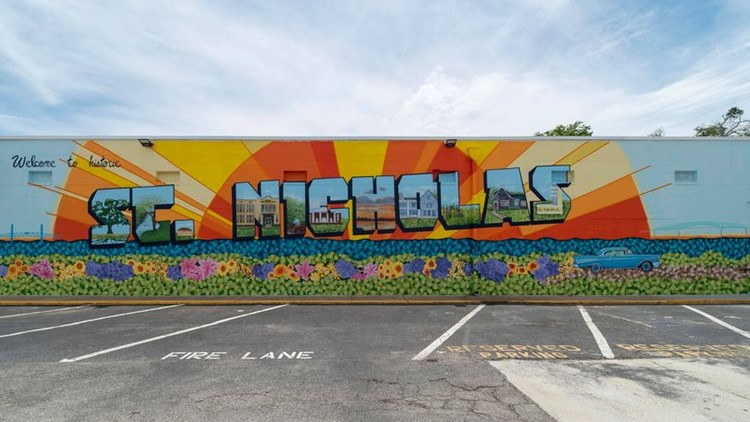JACKSONVILLE, Fla. — There's a new mural in Jacksonville's Historic St. Nicholas neighborhood that showcases the heritage of the area.
Artist Mary Joan Hinson was commissioned to paint the mural, inspired by turn-of-the-century post cards, and featuring her signature flowers. Each letter in the mural depicts a different part of St. Nicholas' history.
Dr. Rene Pulido commissioned the piece, located on the side of the Emed Multispecialty Group building at 2624 Atlantic Blvd., heading east on Atlantic from San Marco.
Hinson, a former art professor at Florida State College Jacksonville, is now a full-time artist. She has painted several murals and works of public art, which her website says "encourages the public at large to become involved in the process of 'art.' They are educated and enriched by the process."
The historic Southbank neighborhood is located where Atlantic and Beach Boulevards intersect, just east of San Marco and I-95.
The following historical information about St. Nicholas is from "Jacksonville's Architectural Heritage," via thejaxsonmag.com:
The northern bank of the St. Johns River at the narrow crossing point called "Cow Ford" by the British and "Pass de San Nicolas" by the Spanish, became the site of the town of Jacksonville in 1822. The southern bank retained the Spanish designation San Nicolas. The Spanish considered building a fort on this southern shore as early as 1740, when British General James Oglethorpe of Georgia (founder of Savannah) was preparing to invade the region. Actual construction did not occur until after 1783, when the Spanish regained the territory following twenty years of British control. The King's Road had been built during the British occupation and had become a major north-south transportation route from the St. Mary's River to St. Augustine. Later the Spanish fortified San Nicolas adjacent to the King's Road, making it a strategic battery for guarding the river crossing, as well as an important northerly point of defense for St. Augustine.
American adventurers, Creek Indians, bands of criminals, and French Republicans all sought to invade the newly re-established Spanish province of East Florida. In 1793, a number of Floridians rebelled against Spanish rule, declared their loyalty to the United States, and fled to Georgia. Among them was Richard Lang, for the previous five years the magistrate for the St. Johns region. Don Juan McQueen, who replaced Lang as magistrate, directed a strengthening of the fortifications at San Nicolas in 1794, anticipating an attack by the French. The following year, a band of rebels led by ex-magistrate Richard Lang attacked Fort San Nicolas and occupied it for several days before fleeing back to Georgia.
The simple triangular battery at San Nicolas was extended in 1802. A description of the fort in 1811, indicates that it had grown to over one hundred feet in length and width and had been surrounded by a log palisade and a moat. Following another invasion in 1817, however, the Spanish abandoned the fort for the final time.
In 1820, the Spanish governor rejected a petition from citizens living around the Cow Ford to form a municipality called San Nicolas. Had it been accepted, the city of Jacksonville might be named St. Nicholas today. Within a year after Florida was ceded to the United States in 1821, the name Jacksonville was given to the settlement north of the Cow Ford.
The area south of the river near the former fort has continued to be known as St. Nicholas (the Anglicized equivalent of "San Nicolas"). After the Civil War and through the late 1800's, the area from the ferry landing (the former JEA Southside Generation Station site) to the Arlington River, including Empire Point, was referred to as "the village of St. Nicholas." Property ownership in this sparsely populated settlement stemmed from two Spanish land grants, one to Francis Bagley and the other to Reuben Hogans.
After Bagley's death, his grant passed on to his widow, Anna Hogans. This property consisted of three hundred acres and extended from Isaac Hendricks' property on the west to just beyond Miller's Creek on the east. The Bagley grant was later divided up among Anna Hogans' five children, and it is this area, west of Miller's Creek, which is called St. Nicholas today.



